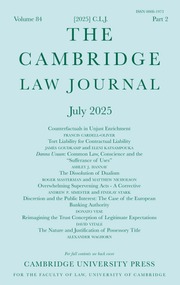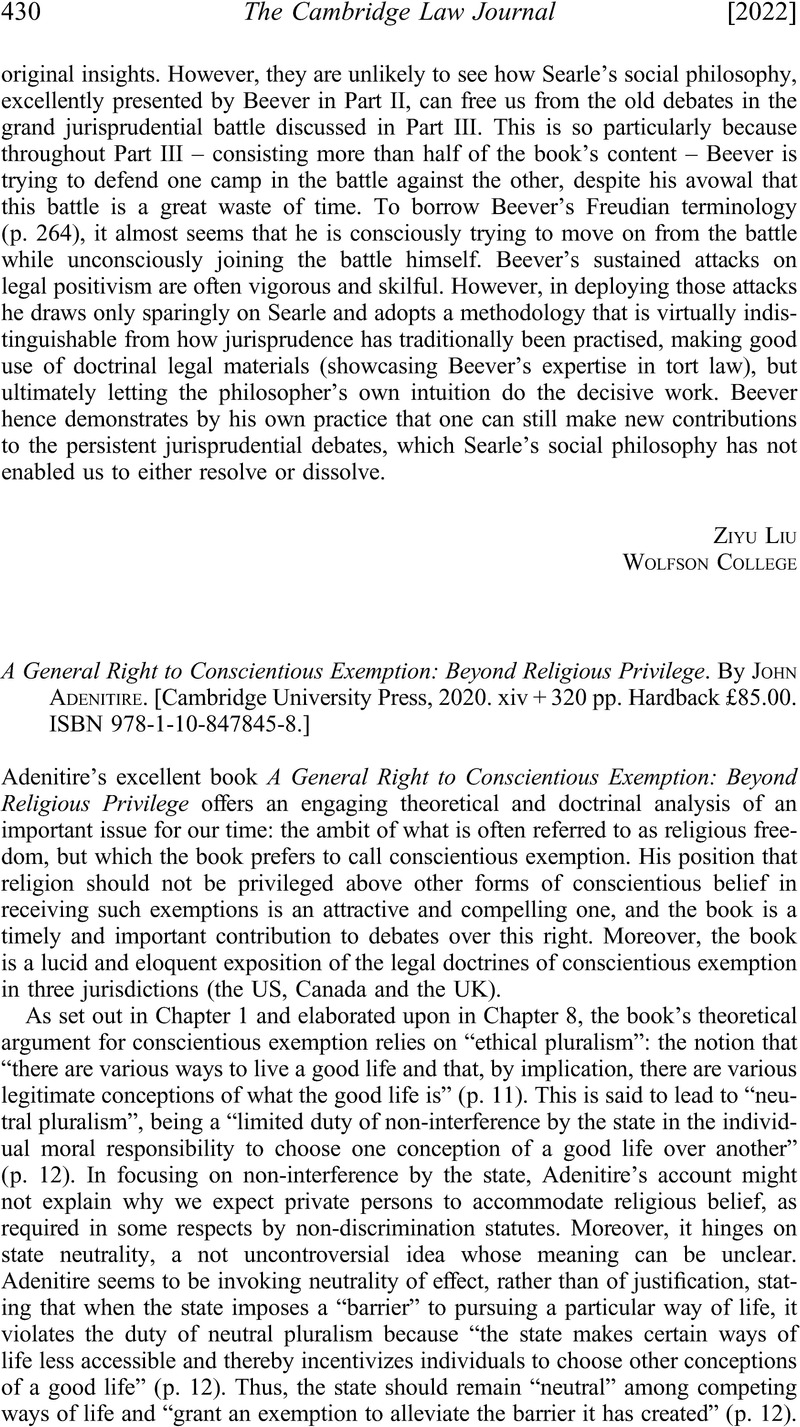Adenitire's excellent book A General Right to Conscientious Exemption: Beyond Religious Privilege offers an engaging theoretical and doctrinal analysis of an important issue for our time: the ambit of what is often referred to as religious freedom, but which the book prefers to call conscientious exemption. His position that religion should not be privileged above other forms of conscientious belief in receiving such exemptions is an attractive and compelling one, and the book is a timely and important contribution to debates over this right. Moreover, the book is a lucid and eloquent exposition of the legal doctrines of conscientious exemption in three jurisdictions (the US, Canada and the UK).
As set out in Chapter 1 and elaborated upon in Chapter 8, the book's theoretical argument for conscientious exemption relies on “ethical pluralism”: the notion that “there are various ways to live a good life and that, by implication, there are various legitimate conceptions of what the good life is” (p. 11). This is said to lead to “neutral pluralism”, being a “limited duty of non-interference by the state in the individual moral responsibility to choose one conception of a good life over another” (p. 12). In focusing on non-interference by the state, Adenitire's account might not explain why we expect private persons to accommodate religious belief, as required in some respects by non-discrimination statutes. Moreover, it hinges on state neutrality, a not uncontroversial idea whose meaning can be unclear. Adenitire seems to be invoking neutrality of effect, rather than of justification, stating that when the state imposes a “barrier” to pursuing a particular way of life, it violates the duty of neutral pluralism because “the state makes certain ways of life less accessible and thereby incentivizes individuals to choose other conceptions of a good life” (p. 12). Thus, the state should remain “neutral” among competing ways of life and “grant an exemption to alleviate the barrier it has created” (p. 12).
However, Adenitire qualifies this argument by accepting that there are limits that apply to claims for conscientious exemptions: “[t]he role of the state … as guardian of the common good … is to ensure that different conceptions of a good life are compatible” (p. 12), and therefore, the state may not grant an exemption if it would disproportionately impact the public interest or the rights of others (p. 227). In his view, these limits can be adjudicated through proportionality analysis (pp. 268–77). In this respect, there is an ambiguity that could be explored further: if neutral pluralism requires non-interference by the state with the choice of a conception of the good life, then it might be asked why these limits do not result in violations of such a duty.
Consistently with the aims of the book, Adenitire's theoretical argument is framed as applying equally to religious and non-religious beliefs (p. 18). He makes the claim that “the liberal state should neither privilege nor disadvantage religious beliefs over non-religious ones when considering whether to grant a conscientious exemption” (p. 252). The book is on strong footing in challenging the positions of those who contend that religion merits special protection, over and above forms of non-religious belief that may be held with equal sincerity (pp. 252–68). As Adenitire shows, if we accept that conscientious exemptions should be granted, there is no satisfactory reason in principle to “privilege” religion and exclude sincerely held non-religious conscientious beliefs.
The book is equally impressive doctrinally. It starts in Chapter 2 with a treatment of US law, contending that a general right to conscientious exemption is grounded by the Free Exercise Clause of the First Amendment and the Free Exercise Clauses of some state constitutions, the Religious Freedom Restoration Act, the Religious Land Use and Institutionalized Persons Act, Title VII of the Civil Rights Act, and the constitutional requirements of Church Autonomy. In Chapter 3, Adenitire argues that the general right to conscientious exemption under these instruments of US law is not limited to religious believers, but is “available to a category of persons who have a sincere belief that complying with a legal rule would involve a moral wrong, irrespective of whether the belief is of a religious nature” (p. 47). As he concedes, a difficulty with this argument is that the instruments in question “explicitly mention religion and no mention is made … of non-religious moral beliefs” (p. 47). However, he relies on the US Supreme Court's decision in Welsh v United States 398 U.S. 333 (1970) to support his view. Welsh related to the interpretation of a statutory exemption in a military service law for conscientious objectors. The plurality found that a “conscientious objection to all war” could be “religious” because it “stem[med] from the registrant's moral, ethical, or religious beliefs about what is right and wrong” where “these beliefs [were] held with the strength of traditional religious convictions”. As Adenitire explains, “the plurality opinion construed the statutory term ‘religious training and belief’ to include deeply held non-religious beliefs” (p. 53).
In addition to seeking wider application of the holding in Welsh, Adenitire makes the claim that restricting conscientious exemption to the religious would violate the Establishment Clause of the First Amendment and the Equal Protection Clause of the Fourteenth Amendment. There is much force to this constitutional argument, though one limitation may be that the Free Exercise Clause, as a constitutional provision, cannot be found to violate other constitutional provisions to the extent that it may privilege religious practice. As a consequence, it might be said that if the US Constitution itself grants exemptions that apply only to the religious through the Free Exercise Clause, it cannot be unconstitutional to do the same thing through statute. Adenitire acknowledges that he is making a controversial argument in the context of the US law (pp. 49–50). Nonetheless, it is persuasively and powerfully made, with detailed analysis of both supportive and opposing authority.
The terrain is easier for the book's doctrinal arguments in respect of Canada and the UK. In Chapter 4, Adenitire outlines how a Canadian general right to conscientious exemption is grounded by the duty of reasonable accommodation under non-discrimination legislation and section 2(a) of the Canadian Charter of Rights and Freedoms. He explains that “the Canadian Charter provides for the protection of both freedom of religion and freedom of conscience in s 2(a)”, so there has “been no need to construe ‘religion’ to include non-religious conscientious beliefs” (p. 103). In Chapter 5, in a point that runs in parallel with his constitutional arguments in the US context, Adenitire claims that even where the duty of reasonable accommodation under non-discrimination statutes refers to religion, “[p]roperly interpreted in light of the Canadian Charter”, there is a “right to conscientious exemption for objectors who hold a non-religious conscientious belief” (p. 149).
The law in the UK is taken up in Chapter 6. The rules of law said to ground a general right to conscientious exemption are the protection for freedom of thought, conscience and religion under the Human Rights Act 1998 and the prohibition of indirect discrimination on the basis of religion or belief in employment and provision of goods and services under the Equality Act 2010. Adenitire documents how in the wake of the decision of the European Court of Human Rights in Eweida v United Kingdom [2013] ECHR 37, a “more robust” understanding of Article 9 of the European Convention on Human Rights has emerged (p. 190). Moreover, as set out in Chapter 7, the Human Rights Act and Equality Act are instruments that explicitly protect non-religious conscientious belief, without the degree of ambiguity that attends the US law and some aspects of the Canadian law.
In Chapter 9, the book addresses one area of real difficulty for proponents of conscientious exemptions: claims for exemptions from non-discrimination laws in respect of same-sex couples on the basis of religious belief. This issue arose most famously in the same-sex marriage cake cases of Masterpiece Cakeshop v Colorado Civil Rights Commission 584 U.S. _ (2018) before the US Supreme Court and Lee v Ashers Baking Company [2018] UKSC 49 before the UK Supreme Court. Adenitire's analysis of this thorny issue is careful, balanced and nuanced. His position is that in most cases “conscientious exemptions from anti-discrimination norms should not be granted … to providers of commercial services because doing so would cause unjustifiable dignitary harms to members of the Lesbian, Gay and Bisexual (‘LGB’) community as the law would allow them to be classed and treated as second-class citizens” (p. 280).
Non-discrimination norms are said to prevail because the conflict is between “the dignity of LGB members” and “a claim to complicity in immorality/sinfulness of those that seek an exemption” (p. 280). The book's invocation of dignity might arouse some of the usual objections to the concept, including that dignity, in a conflict of rights, tends to point in both directions as all rights may be perceived to implicate their holder's dignity. Here, it may be questioned whether the dignity of a religious believer is truly not affected by compelling her to offer significant material support to a practice, such as same-sex marriage, that she opposes on religious grounds. Nonetheless, Adenitire is surely correct to observe that an objection to selling cakes to same-sex couples “engages the core of the right to non-discrimination” while only “the periphery of freedom of religious and non-religious conscience” (p. 280) – taking place in the commercial sphere, it has nothing to do with, for instance, religious worship.
Although ambitious in both its theoretical and doctrinal arguments, Adenitire's analysis is incisive as well as highly readable. A General Right to Conscientious Exemption is likely to be of great interest to scholars and students of liberty of conscience and, as it addresses the case law in a clear and comprehensive way, it may also prove an invaluable resource to practitioners in human rights and constitutional law in the three selected jurisdictions.


